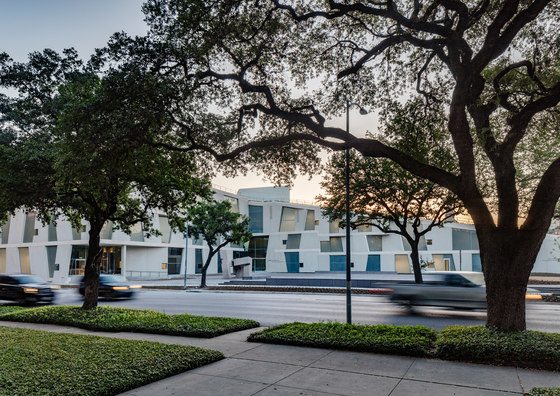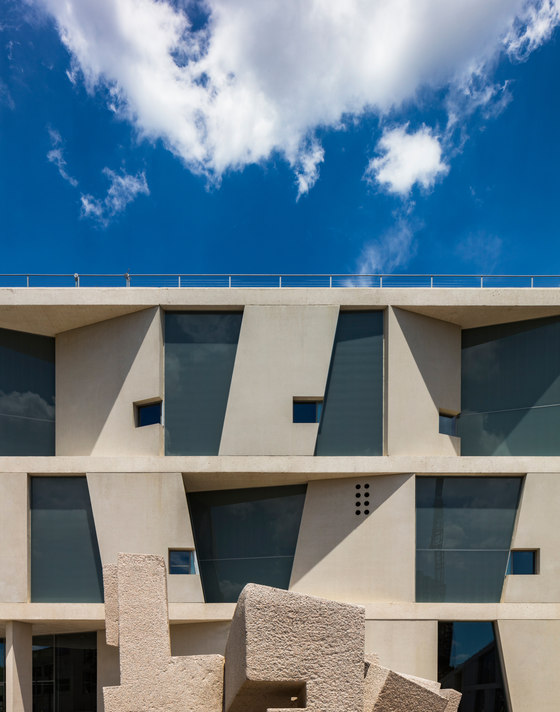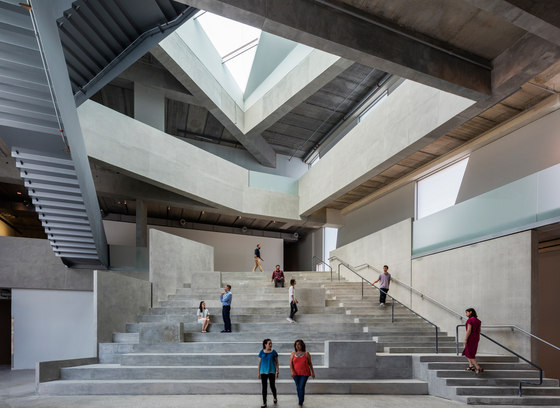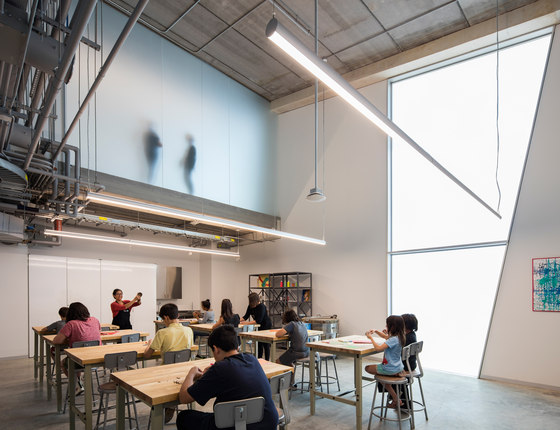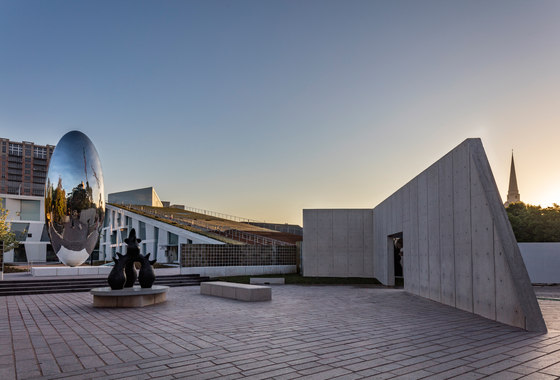The completion of the Glassell School of Art—the nation’s only museum-affiliated art school serving pre-K through postgraduate students—and the The Brown Foundation, Inc. Plaza opens a public gateway to the entire Susan and Fayez S. Sarofim Campus and creates a dramatic new public greenspace for Houston. The 14-acre redevelopment is currently the largest cultural project under construction in North America.
“As we reveal not only a glorious new building for the Glassell School, but also a public plaza, large fountain, amphitheater, and roof garden, I think Houstonians will quickly grasp that our project intends to create a new destination for the city,” said Gary Tinterow, director of the MFAH. “With this phase of the campus redevelopment now accomplished, and with Nancy and Rich Kinder’s extraordinary pledge, we are well positioned for the campus completion, in early 2020. The entire project is a testament to Houston’s historic legacy of city building through arts-and-culture philanthropy, which the Kinders exemplify.”
About the Glassell School of Art
Steven Holl Architects’ dramatic, L-shaped design for the Glassell School of Art features a sloping, walkable roofline that runs the length of the building and connects two prominent gathering places: the wide-stepped amphitheater seating at its base and the BBVA Compass Roof Garden above. The interior of the 93,000-square-foot school features three dozen studios, all illuminated with natural light and designed to serve more than 8,500 children and adults annually; public gallery spaces for exhibitions by students and alumni; a broad-stepped central staircase that serves as the school’s forum; a 75-seat auditorium; and a public coffee bar. Classes in the new building begin June 4, 2018, with the start of the school’s popular summer sessions for children.
Joseph Havel, director of the Glassell School of Art, said, “For nearly four decades, the Glassell School has been an essential center for Houston’s diverse and active art community, reflecting the Museum’s commitment to developing future generations engaged in the arts. The new building brings our mission as the teaching wing of the MFAH to an entirely new level. The drama and beauty of the design, matched to an exceptionally functional and durable building made specifically for art-making practices, will challenge the imaginations of our faculty and our students.”
“Our building for the Glassell School is a key part of the overall strategy to shape the public spaces for the entire campus,” commented Steven Holl. “The alternating concrete and glass panels create a porosity between indoors and out, and the gathering spaces—including the building’s walkable, sloping roof—provide a civic experience for students and the public alike, with spectacular views of the neighborhood and the city skyline.”
“The vision that was laid out in 2015 at this building’s groundbreaking has come to fruition in the most amazing way with a form and structure that is befitting a cosmopolitan and growing city like Houston,” said Onur Genç president and CEO of BBVA Compass. “Its addition to the MFAH campus gives the full spectrum of people, from young to old and everything in between, the ability to access and create art in a new way. BBVA Compass is proud to have been a part of creating that opportunity and helping advance this city in such a meaningful—and lasting—way.”
The origins of an MFAH school date to 1927, when the Museum’s first school was established, three years after the Museum’s 1924 opening. The Glassell School of Art opened in 1979, following a founding gift from trustee Alfred C. Glassell, Jr., who was committed to advancing the Museum’s art-education mission. In 1982, the Core Residency Program was established for artists, and in 1998 a critics’ residency was added. Today, the Glassell School of Art is the only museum school in the United States with programs that serve students of all ages, from 3-year-olds, to adults, to the postgraduate artists and critics of the Core Program. Notable Core alumni include artists Trenton Doyle Hancock, Julie Mehretu, and Shahzia Sikander. Each year, the school offers more than $100,000 in scholarships and enrolls about 7,000 students. Enrollment is expected to grow to 8,500 in the new Steven Holl Architects–designed building, which doubles the space of the original.
About The Brown Foundation, Inc. Plaza
The Brown Foundation, Inc. Plaza’s generous expanse is designed by Deborah Nevins & Associates in collaboration with Nevins & Benito Landscape Architecture, D.P.C. The plaza provides the dramatic setting for a reflecting pool, a shaded seating area, and two monumental public sculptures: Cloud Column (1998–2006), a 32-foot-high stainless steel form by Anish Kapoor; and Eduardo Chillida’s stacked-granite Song of Strength (1966). The roofline of the school is landscaped and fully accessible, extending the plaza up and along the entire length of the building.
Redevelopment Overview: The Susan and Fayez S. Sarofim Campus
The 14-acre campus transformation is the largest cultural project currently underway in North America, with some 500,000 square feet in new construction. Sited in the heart of Houston’s Museum District, the Sarofim Campus will be a major contribution to the city’s efforts to improve the pedestrian experience of Houston. With its generous array of public plazas, reflecting pools, and gardens, as well as improved sidewalks, lighting, and way finding, the campus will provide an active setting for a century’s worth of architecturally significant buildings and three new structures: the Glassell School of Art and the Nancy and Rich Kinder Building (Steven Holl Architects, May 2018 and early 2020), and the Sarah Campbell Blaffer Foundation Center for Conservation (Lake|Flato Architects, late 2018).
The project will expand the role the Museum plays in the daily life of Houston, not only as a cultural institution but also as an urban oasis open to all, invigorating the surrounding area. The redevelopment is projected to be of significant economic benefit to the city, as well: in the near term through job creation, and in the long term by generating nearly $334 million in economic activity over 20 years, with more than $2.5 million in direct, indirect, and induced city tax revenues.
About the Museum of Fine Arts, Houston
Established in 1900 and opened in 1924, the Museum of Fine Arts, Houston, is one of the largest cultural institutions in the country. The Museum’s encyclopedic collections are especially strong in Pre-Columbian and African gold; Renaissance and Baroque painting and sculpture; 19th- and 20th-century art; photography; and Latin American art. The two house museums of the MFAH—Bayou Bend Collection and Gardens, and Rienzi—present collections of American and European decorative arts. The MFAH is also home to the International Center for the Arts of the Americas (ICAA), a leading research institute for 20th-century Latin American and Latino art.
Steven Holl Architects
The Brown Foundation, Inc. Plaza designed by Deborah Nevins & Associates in collaboration with Nevins & Benito Landscape Architecture, D.P.C
